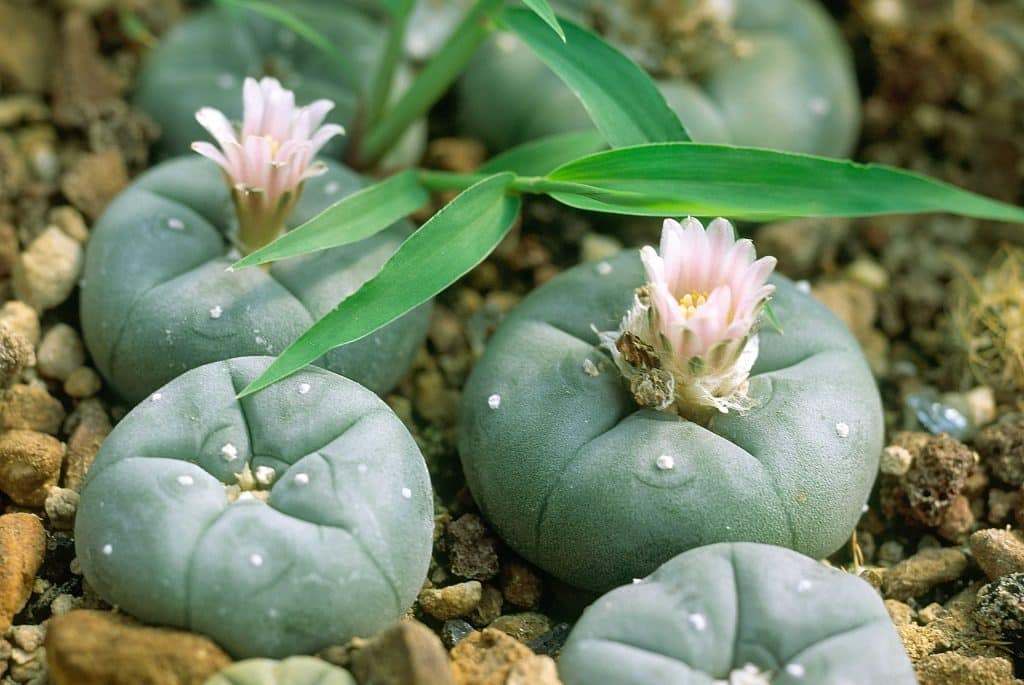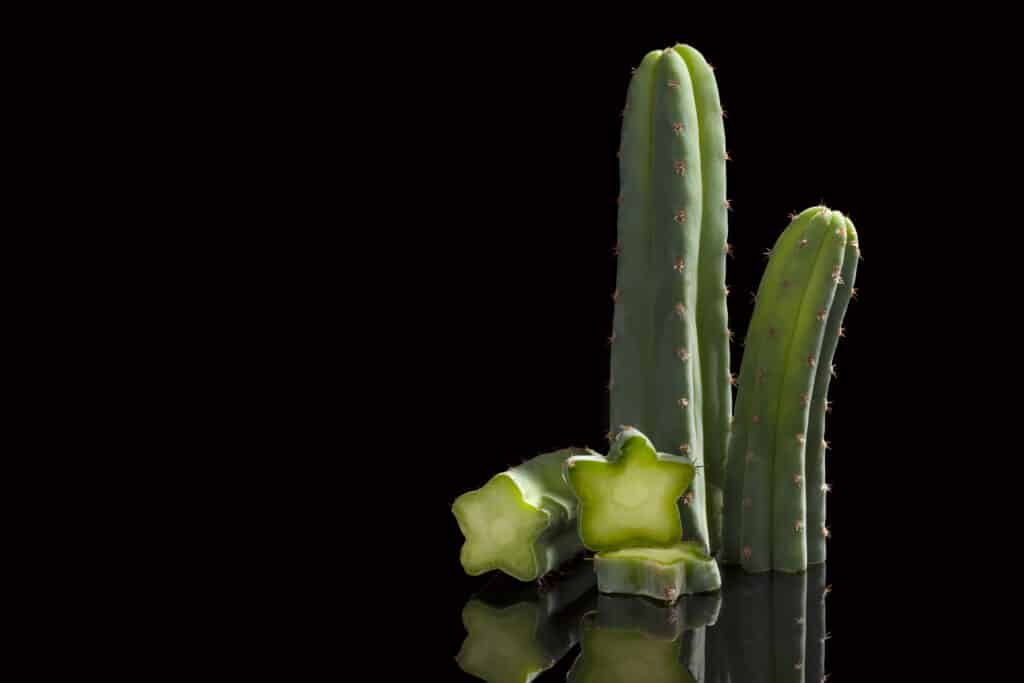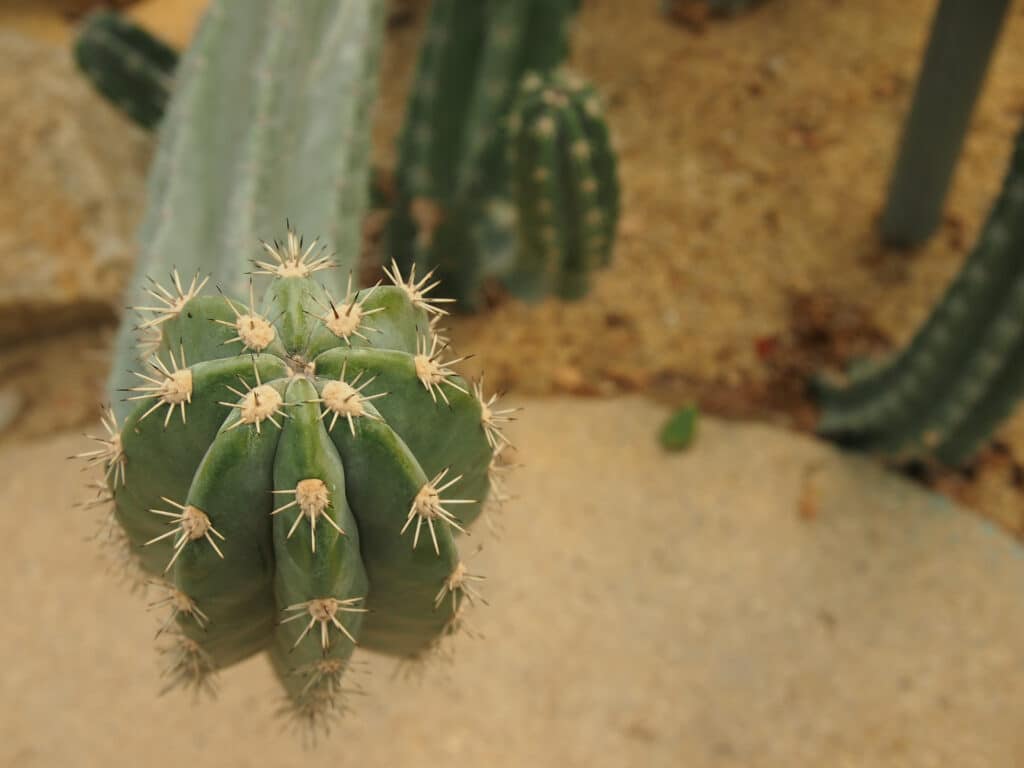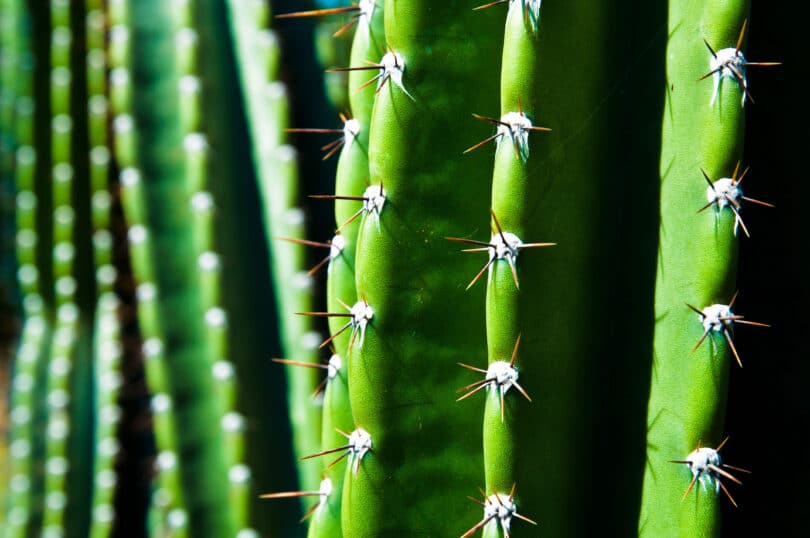When we think of trippy cacti, mescaline generally comes to mind. And rightfully so, as very few other cactus compounds are truly psychedelic. That being said, most people tend to associate mescaline with peyote, but peyote is illegal in the United States. What many don’t realize is that many other, completely legal cactus species contain mescaline also. Let’s learn more about a few of the other popular varieties.
What is mescaline?
Mescaline (3,4,5-Trimethoxyphenethylamine) is a naturally occurring, plant-based psychedelic protoalkaloid belonging to the phenethylmine class. Like other drugs from this class, mescaline has an affinity for serotonin receptors. Although it binds to virtually all serotonin receptors in the brain but has a stronger affinity for the 1A and 2A/B/C receptors.
Aside from Peyote, which is the most well-known, mescaline can be synthesized from a few other cactus species as well, a few of which we’ll discuss in further detail later on. It’s known for its powerful hallucinogenic properties, comparable to those of LSD and psilocybin.

A common dose for mescaline is roughly 200 to 400 mg, depending on the person’s size, level of experience with the compound, and other factors. Traditionally, San Pedro dosing is calculated at roughly 3.75 mg/kg of weight. However, potency can vary wildly from cactus to cactus, so it can be quite difficult to get consistency in dosing. For example, 50 grams of powdered cactus can have anywhere from 150 mg to 1,150 mg of mescaline. Factors such as where and how the cactus grew and access to water and sunlight can influence the plant’s potency.
Mescaline produces a number of effects, including intense hallucinogens, with both open and closed-eye visuals; distortion in time, sound and vision; an increase in introspective and conceptual thinking; the loss of ego; and feelings of euphoria. It’s often considered gentler than other psychedelics with a less negative come-down, while possibly producing greater insight than these other compounds. It’s the subject of a growing body of research for its potential medical properties.
Mescaline has a rich history of traditional and spiritual use dating back thousands of years. Native Americans have long used peyote as a religious sacrament (Peyotism) and in the early 1800s, the modern-day Native American Church (NAC) was formed. The 1994 amendment to the American Indian Religious Freedom Act legalized the use of peyote for members of this church. However, it’s banned for everyone else in the United States.
Mescaline-producing cacti
Many cacti are known to be psychoactive, containing phenethylamine alkaloids such as mescaline, or other mind-altering compounds. Cacti that produce mescaline specifically, can be found growing throughout North and South America, with more prominence in certain areas such as most of Mexico and the Andes region which stretches throughout Venezuela, Colombia, Ecuador, Peru, Bolivia, Chile and Argentina.
The two genera that are most often used for spiritual and ritualistic purposes are Echinopsis, which contains the San Pedro cactus group; and Lophophora, which has peyote. Several other species contain mescaline and are just as potent, but do not have the same historical background.
Peyote
Peyote (Lophophora williamsii), or “the sacred one”, is by far the most well-known of the mescaline cactus types. It’s been talked about in movies, literature, and music, and also depicted in many types of visual artwork such as paintings and photographs. It’s a very slow-growing, spinless, flowering, button cactus that is greenish-blue in color, sometimes with hints of grey.

The Peyote cactus grows among thorny shrubs in the high desert regions of Central Mexico to Southwestern Texas, mainly between 330 and 4,920 ft, although in some rare circumstances, it has been found at elevations as high as 6,200 feet.
It’s a very hardy plant that can grow in many different types of increment weather conditions. Mainly, it just needs that dry desert air. It’s common to find it growing on or near limestone hills. It flowers in between March and May, and the flowers are pink and white with thigmotactic anthers. It grows in the wild from central Mexico to Southern Texas.
In traditional peyote preparations, the top of the cactus is cut off, leaving the large tap root along with a small, green photosynthesizing area where new heads can grow. These heads are then dried to make disc-shaped buttons. The buttons are chewed or soaked in water to make a beverage. An average dried button weighs about 2 grams, and it would take 6-10 buttons to produce psychedelic effects. Peyote is extremely bitter though, so more contemporary users will usually grind the dried buttons into a powder and pour into capsules to consume.
San Pedro
San Pedro (Trichocereus/Echinopsis pachanoi) is a tall, thin flowering columnar cactus that grows in clumps. Each column has 7-9 ridges with small clusters of spines along the edges. The clumps can grow up to 14 feet tall and contain a substantial amount of mescaline. It hails from the Andes Mountain region of South America. It also grows well in the Southwestern US, as far north as Colorado, although it truly thrives in California and Arizona, where it can be seen with regularity in residential areas and shopping centers.

Their fast growing nature has seen San Pedro cacti become very popular in the last decade, although it too is steeped in history. Use of San Pedro can be traced back to the pre-Columbian Chavin culture that developed in Peru between 1300 to 200 BCE. This is evidenced by numerous stone carvings depicting mythical beings holding San Pedro cacti, the oldest of which was discovered in an old temple at Chavin de Huantar in the northern highlands of Peru. Numerous other artifacts from the region bore San Pedro symbolism as well, and perhaps the most concrete proof of its use are the 3,000-year-old cactus cigars found in the same cave as the carvings.
Even today, San Pedro is sold at numerous markets in the country and in 2022, the Peruvian Ministry of Culture declared the traditional use of San Pedro cactus in northern Peru as part of their cultural heritage. Traditionally, San Pedro can be consumed either on its own or mixed with other plants in a psychedelic, ceremonial brew called cimora.
It can also be bought online or at gardening stores in the US with relative ease because it’s federally legal. And because there are no laws against possession of San Pedro, it’s one of the longest-studied psychedelics, as well as the first cactus to be labeled with the term (psychedelic). Dosing can be challenging as potency varies considerably. There are San Pedro that are completely inactive and won’t do anything, and there are some that are strong enough that you only need a couple inches of fresh plant to feel a good high – so there is a certain level of trial and error involved to figure out what is best for each person.
Peruvian Torch
Peruvian Torch, or Trichocereus Peruvianis, is often confused for San Pedro but it’s slightly different. It’s distinguished by its blue shade and longer spines. Not only are the spines longer, but they’re also a different color – San Pedro spines are yellow, whereas the Peruvian Torch spines start off as a brownish-yellow and turn to bone white as they age.

Additionally, Peruvian Torch is said to be much more potent than San Pedro, although honestly, it’s hard to find any reliable information on this other than word-of-mouth and reddit posts. It seems that, although some of the highest recorded concentrations of mescaline have been from San Pedro cactus varieties, so have some of the lowest. Peruvian torch seems to be more consistent on the higher end.
Bolivian Torch
Bolivian Torch, or Echinopsis lageniforis, is another fast-growing columnar cactus that bears many similarities to San Pedro and Peruvian Torch. Origins of its use can be tracked back to the indigenous shamans of La Paz, Bolivia, who would refer to this cactus as “Achuma” or “Wachuma”.
Bolivian Torch has much higher levels of mescaline than both Peruvian Torch and San Pedro with roughly 0.56 percent by dry weight, although concentrations did vary a bit based on the location of the cactus. All you need is about 0.3 to 0.4 grams to produce the desired effects, which is typically a noticeable psychedelic experience. They also get quite tall, up to 15 feet and some of the mature ones produce a big, blooming flower right on the top.

Interestingly, they still are not as popular as one would expect, given the benefits of choosing this cactus over other mescaline producing varieties. One reason is because they simply are not very well known. Another reason is because people often use the names Bolivian Torch, Peruvian Torch, and San Pedro interchangeably, believing they are all different terms for the same cactus when in fact, they only look similar and all contain mescaline.
Other psychedelic cacti
There are roughly 300 cactus types that produce psychoactive compounds. It’s usually mescaline, but not always; although the other psychedelic cacti are even less researched than the mescaline ones, so very little is known about the potential of these agents. There could be several hallucinogens in these cacti that are yet to be discovered.
Another species of cactus, the Echinocereus triglochidiatus, is suspected to contain a tryptamine-derivative that is similar to 5-MeO-DMT (5-methoxy-N,N-dimethyltryptamine), although again, there is not much literature on the subject.
Some other fairly well-known psychoactive cacti (among psychonauts and botanists at least) are Ariocarpus species with numerous phenethylamines, which are often referred to as “maddening drugs”. However, the mechanisms of how these compounds work is still not very well understood. Additionally, some cacti contain stimulants, and others contain compounds that can be used for pain relief.
Final thoughts
Plants are fun, and while trying to research psychedelic cacti it became abundantly clear that there is so much in nature that we still know nothing about. A lot of cacti contain mescaline, and we’re now learning that several may contain other psychoactive compounds, many of which have yet to be studied in any capacity. It’s exciting to think what the future of psychedelics holds.
Welcome cannabis aficionados! Thanks for making your way to Cannadelics.com, an independent news site going deep into the worlds of cannabis, psychedelics, and well beyond. We’re big on updates, so come by regularly. And get yourself signed up to the Cannadelics Weekly Newsletter, for the best in related product offerings, as well.










that’s a bad photo of bolivian torch
It’s hard to find good stock photos, if you have a better one I could use, feel free to send it to me and I will give proper credit alexandra@cannadelics.com